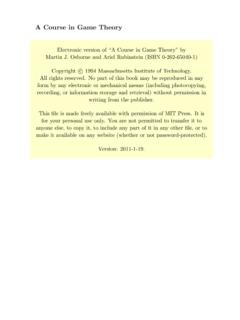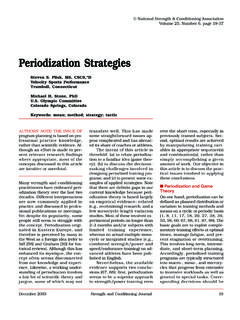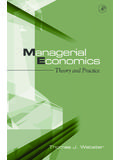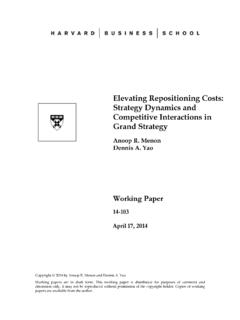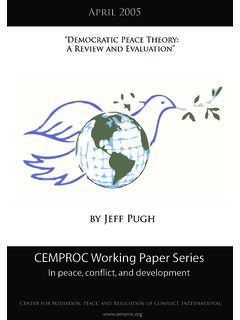Transcription of THE APPLICATION OF THE GAME THEORY TO THE …
1 929 15th International Research/Expert Conference Trends in the Development of Machinery and Associated Technology TMT 2011, Prague, Czech Republic, 12-18 September 2011 THE APPLICATION OF THE GAME THEORY TO THE OLIGOPOLISTIC MARKET Zdenka Dragasevic, PhD Svetlana Rakocevic, PhD Nevenka Glisevic, PhD Faculty of Economics Jovana Tomasevica St. 37, Podgorica Montenegro ABSTRACT In the modern economy, where there is a strong correlation between business undertakings and profit, the profit of a subject depends not only on its behaviour, but also on the behaviour of other participants in the decision making process. Therefore, the decision maker should analyze the strategies that have been chosen or will be chosen by his opponents, but also to perform analysis of the strategies that other decision makers will choose in a response to the strategy which has yet to be chosen.
2 To select an optimal strategy, on the oligopolistic market, decision makers can use game THEORY . Game THEORY is a mathematical THEORY that is used for analysis and solving of conflict situations, in which participants have opposing interests. The concepts of game THEORY provide a tool for formulating, analyzing and understanding different strategies. It attempts to address the functional relationship between the selected strategies of individual players and their market outcome, which may be either profit or loss. In this paper the key aspects of game THEORY have been used to show how it can be implemented for understanding the development and functioning of the oligopoly market and how managers need to think about the strategic decisions. Key words: game THEORY , oligopoly, strategies, price 1.
3 INTRODUCTION Game THEORY is a specific method of analysis of social phenomena and processes. It is one of the possible ways of interpreting human behaviour and choice in conflict and partially conflict situations. These involve all the situations in which the final solution depends not only on one party, a player who makes the decision, but also on the decisions made by other participants. These behaviours are interdependent, they exert influence both on one another and on the final result of the decision making process. One of the forms of the market structure is oligopoly. It is a market in which only a few companies compete, with products that can be differentiated but are not necessarily so. Another important feature of oligopoly markets is that there are barriers to entry for new companies. The monopoly power and profitability of the oligopoly companies depend in part on the interaction between the companies.
4 If they cooperate, companies can charge prices well above marginal cost and, thus, can earn large profits. If they compete aggressively, this will result in low prices and, consequently, in lower profits. Why do companies in some oligopolistic markets collaborate and in others compete fiercely? How do companies set prices? The answers to these questions will be obtained through the APPLICATION of game THEORY , which has made a significant contribution to the analysis of strategic decision making in oligopoly companies. 930 2. THE BASIC CONCEPTS OF GAME THEORY Game THEORY is a mathematical THEORY that is used for the analysis and resolution of conflict situations in which parties have opposing interests. The concepts of game THEORY provide a tool for formulating, analyzing and understanding different strategies. It attempts to address the functional relationship between the selected strategies of individual players and their market outcome, which may be either profit or loss.
5 A game is any situation in which players, participants in the game, make strategic decisions, taking into account actions and reactions of others. A strategy is a rule or plan of action for playing the game. For example, for an oligopoly company which needs to determine the price of its products, a possible strategy is to maintain a high price as long as that is how my competitors act, but when some of the competitors lower their price, to lower my price even further [3] The main objective of game THEORY is to determine the optimal strategy for each player. The optimal strategy is defined as a strategy that maximizes the expected return of the player. The mechanisms of game THEORY allow a study of a large number of possible strategies, from a total agreement to a conflict of interest. Also, the economic game in which companies participate can be cooperative, when participants in the game may enter into binding contracts that allow them to plan mutual strategies and achieve greater profit, and non-cooperative in which there can be no negotiations or implementation of mandatory agreements between players.
6 In addition to these games there are repeated games (an infinite number of times - pricing of products) and games that are not repeated (decisions made only once). In the contemporary economic conditions the most important element of each game is setting strategic objectives, especially in those games that are repeated an infinite number of times, such as, for example, determining the price of a product. 3. AN OLIGOPOLY AS A MARKET STRUCTURE Oligopoly is a prevalent form of market structure. This is one of the intermediate forms between pure competition and pure monopoly. The characteristics of oligopoly markets are to harbour a few businesses and that the entry of new companies is limited. Products can be differentiated (as in the automotive industry), but not necessarily so (as in the steel industry). The scope of the monopoly power of companies partially depends on the interaction that exists between them.
7 In some oligopolistic industries, companies cooperate, and in others they implement aggressive competition, and consequently achieve lower profits. In decision making in an oligopolistic market, one must take into account possible reactions of the competitors. In addition, we assume that companies, as subjects, act rationally, that is, think about the consequences of their actions. Game THEORY is widely applied in oligopolistic market situations research. In fact, many of the central problems of oligopoly depend on strategic reciprocal relations that exist between the market participants. The issue of the strength of the above mentioned reciprocal connections is especially important, and game THEORY models provide answers to this question. For this paper purposes, we will simplify the analysis of an oligopoly market and, therefore, consider the case of duopoly, or the existence of only two companies in the market.
8 Each company has only one competitor that must be taken into account when making its decisions. By an example of duopoly (company A and company B) we will show how companies, by choosing price as a strategic variable, can achieve an advantage in the market. 4. EQUILIBRIUM IN AN OLIGOPOLY MARKET A duopoly in an oligopolistic market is comprised of two companies, which may or may not produce differentiated products. Let us assume that there are two companies that produce a homogeneous product. Then there will be four variables that may be of interest for us. These are the prices (p1, p2) which are determined by each company and the quantities (q1, q2) produced by each company. The company should first decide on the strategic variables with which it wants to achieve a competitive advantage. If two companies make decisions simultaneously on the amount they need to produce, whereby the market determines the price, then we talk about the Cournot duopoly model.
9 If one company decides on the quantity or price before the other company, it becomes a leader either in quantity or price, which is explained by the Stackelberg duopoly model. When both companies make decisions 931 simultaneously on the price of their product, with the amount determined by the market, we talk about the Bertrand duopoly model. Each company determines the price by which it will maximize profits, according to the given choice (price) of the other company. When the market is in equilibrium, the companies operate as best as they can and have no reason to change prices or production quantities. The competitive market is in equilibrium when the total supply equals total demand. Then each company operates as best as it can, because it sells all it produces and maximizes its profits. A monopolist is in equilibrium when marginal revenue equals marginal cost.
10 Then the monopolist achieves the maximum profit. In an oligopolistic market, a company determines the price and quantity taking into account the behaviour of its competitors, whereas the competitors decisions depend on the decisions of the company. Is there equilibrium in an oligopolistic market at all? When is oligopoly equilibrium achieved? Yes, oligopolistic market equilibrium exists and is known as Nash equilibrium. Nash equilibrium is based on the fact that every company operates as best as it can, considering the performance of its competitors. When companies are in Nash equilibrium, neither of the companies has incentive to disturb it, because each operates as best as it can, that is, achieves the highest profits (as well as its competitor) with the strategy chosen. 5. APPLICATION OF GAME THEORY IN AN OLIGOPLY MARKET One of the strategies that can be applied by an oligopoly company is pricing of products, whereby the demand for the products of a company depends on the price of the product of that company as well as the price of the product of the competing company (we will assume that these products do not differ in other characteristics, so that only a change in price determines changes in demand for that product).


